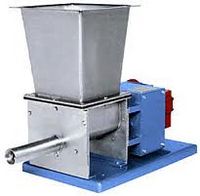Volumetric Feeders
Volumetric Feeders are universally acclaimed for their unique ability to accurately and reliably feed an extremely broad variety of dry solid ingredients. These innovative and technologically superior designs provide a high degree of versatile volumetric metering performance. The quality of construction and durability of these volumetric feeders is unsurpassed; their maintenance requirements are the lowest in the industry. A true volumetric feeder encompasses a positive method of measuring a specific volume of product and a means to effectively discharge that material, generally over a variable range. With an auger type volumetric feeder, the auger is the means used to measure volume, discharging the “measured” volume of material with each revolution, as it typically rotates through a discharge spout. Consequently, the viability of any auger type volumetric feeder is dependent upon how uniformly and consistently the feed auger is filled with product, and how reliably this is accomplished. Even in view of today’s technological accomplishments, the precise and dependable volumetric metering of dry solid ingredients remains far more of an art than a science; unquestionably, specific expertise and experience plays the most crucial role. And since it is also a well-established fact that no single approach to dry solids volumetric metering has been able to solve all materials-handling variables, Acrison has designed and manufactures a number of different auger type volumetric feeder models in order to successfully handle the incredible number and diversity of dry solid materials. Each of these individual volumetric feeder models possesses specific functionality, suitable to handle a range of product characteristics. For example, feeding very free-flowing products such as coffee beans, grass seed or plastic pellets really doesn’t require much mechanical sophistication; however, to accurately and dependably meter sluggish amorphous materials, especially those with adhesive, cohesive and/or pressure sensitive characteristics, is a challenge. Today, dry solid volumetric feeders that range from single auger volumetric feeders to handle the generally easier free-flowing materials, to various type dissimilar speed, multiple auger and agitated flat bottom volumetric feeders for the more difficult-handling products.
Video
